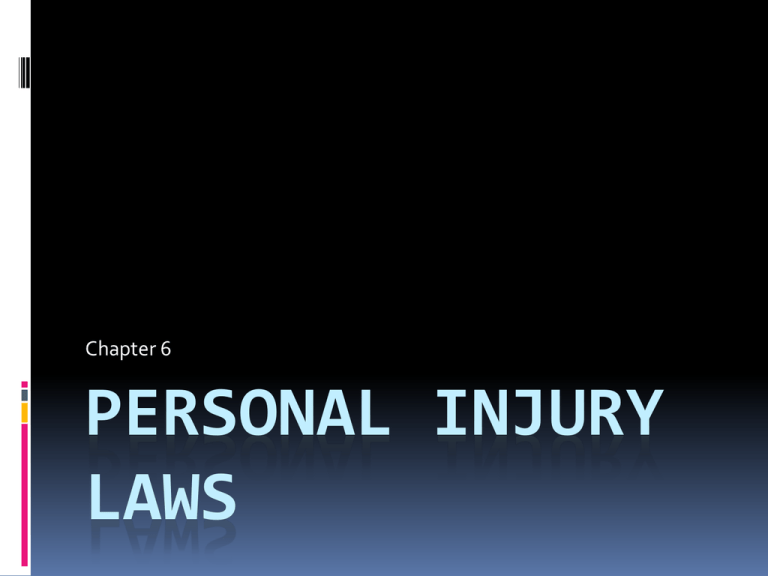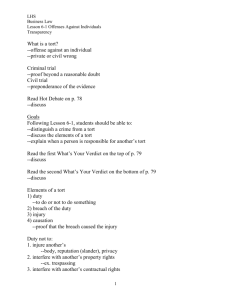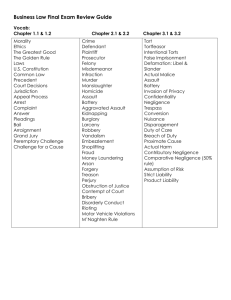Presentation
advertisement

Chapter 6 PERSONAL INJURY LAWS Hot Debate 1. Do you think the manufacturer should be responsible for paying Shana’s medical expenses? 2. What defense does the manufacturer have against a suit for damages for her injury? Hot Debate Answers 1. If the woodcutting machine was defectively manufactured, the manufacturer is strictly liable for the injury. Your neighbor can recover even thought the warranty has expired. Even if the manufacturer were not legally liable, he would still be morally obligated to pay the medical expenses. Hot Debate Answers 2. If the product was unreasonably dangerous due to the defect, the maker/seller would be strictly liable. What’s Your Verdict Although Josephina was asleep at the time, has she violated any rights of the other driver? What’s Your Verdict Answer Josephina committed an offense against society-the crime against reckless driving. She also committed a tort by injuring John and his property. He can bring a civil suit against her. Her reckless driving caused her to be liable both criminally and civilly. How do crimes and torts differ? A crime is an offense against society, it’s a public wrong. A tort, is a private or civil offense against an individual. Money damages received as a result of a tort is intended to compensate for the injury. One act can be both a crime and a tort. What’s Your Verdict? Did Mason commit a tort? Elements of a Tort In a trial, these elements must be proven to establish legality (legal responsibility) Elements of a Tort 1. Duty ( a legal obligation to do or not to do something) 2. Breach (a violation of the duty) 3. Injury (a harm that is recognized by the law) 4. Causation (proof that the breach caused the injury) Duty The following are the duties created by the tort of law: 1. The duty not to injure another (including bodily injury, injury to someone’s reputation, or invasion of someone’s privacy) 2. The duty not to interfere with the property rights of others. (for example: trespassing onto someone’s land) 3. The duty not to interfere with the economic rights of others, such as the right to contract. What’s Your Verdict? Duty Mason committed a tort because: 1. He owed a duty to the neighbors not to injure their property. Breach of Duty or Violation A breach (or violation) of the duty must be proven before the injured party can collect damages. What’s Your Verdict? Breach Mason committed a tort because: 1. DUTY-He owed a duty to the neighbors not to injure their property. 2. BREACH-He breached the duty when he left the fire unattended so it spread to the neighbor’s property. Injury Some torts require that the breach be intentional, while in other torts, intent is not required. (In other words, not ALL torts require that the defendant intended in injure the plaintiff. Injury resulting from the breach of duty must be proven. What’s Your Verdict? Injury Mason committed a tort because: 1. DUTY-He owed a duty to the neighbors not to injure their property. 2. BREACH-He breached the duty when he left the fire unattended so it spread to the neighbor’s property. 3. INJURY-The injury occurred when the neighbor’s house burned. Causation Causation means that breach of the duty caused the injury. When the amount of causation is great enough for it to be recognized by the law, it’s called proximate cause. What’s Your Verdict? Causation Mason committed a tort because: 1. DUTY-He owed a duty to the neighbors not to injure their property. 2. BREACH-He breached the duty when he left the fire unattended so it spread to the neighbor’s property. 3. INJURY-The injury occurred when the neighbor’s house burned. 4. CAUSATION-Leaving the fire unattended was a proximate cause of the loss of the fence, the tool shed, and the house. What’s Your Verdict? Who was liable for Hunt’s injuries? What’s Your Verdict? Answer Patterson would be liable to Hunt even though Patterson was only 17 years old. Saddleback Stables was liable for the negligence of its employee Patterson. In such cases, the injured party may sue both employer and employee. Responsibility for the Torts of Another All people, including minors, are responsible for their conduct and are therefore liable for their torts. Children and even insane people may be held liable for injuring others. When one person is liable for the torts of another, the liability is called vicarious liability. Responsibility for the Torts of Another With some exceptions, parents are not liable for the torts of their children. In some states, parents are liable, by statue, up to a specified amount of money for property damage by their minor children. Parents can be liable if they give their children “dangerous mentalities” such as guns, without proper training. What’s Your Verdict? Was Hart guilty of a tort? What’s Your Verdict? Answer Yes, he was guilty of trespass to land, even though he thought he was in a national forest. Common Intentional Torts Intentional torts are torts for which the defendant intended either the injury or the act. Assault Occurs when one person intentionally threatens to physically or offensively injure another. The threat can be made in words or gestures. The threat must be believable, and must be an ability to carry it out. Example: raising a fist threatening to punch you or unwanted sexual touching by threatening to kiss you. Battery A person has a duty to refrain from harmful or offensive touching of another. Examples: Shooting, punching, pushing in anger, spitting on, or throwing a pie in another’s face Some acts can involve both assault and battery. When you act in self defense, you have not committed battery. False Imprisonment Depriving a person of freedom of movement without the person’s consent and without privilege. Examples: being handcuffed; locked in a room, car, jail; told in a threatening way to stay in one place Sitting in a police car voluntarily, talking to police about an incident is not false imprisonment. Police must have a reasonable basis for arresting someone, which is a privilege that justifies the imprisonment. Defamation Statements about people can injure them. If a false statement injures one’s reputation, it may constitute the tort of defamation. If spoken, it’s slander If written or printed, it’s libel A complete defense for slander and libel must show that the statement is true. Defamation Must be false Be communicated to a 3rd person )one’s reputation is not harmed if no other person hears or reads the lie) 3. Bring the victim into disrepute, contempt, or ridicule by others There is no liability in such cases unless the statement was made with malice (statement was known to be false when made). Public officials, celebrities, judges, lawyers, jurors, witnesses, and other parties in judicial proceedings are immune from liability for statements made during the actual trial or hearing. 1. 2. Example: Eminem's Mother May Drop Defamation LawsuitDebbie Mathers-Briggs tells British TV show she never intended to sue rapper son for $10 million. http://www.accesshollywood.com/_article_10115 Invasion of Privacy Being entitled to keep personal matters private. Invasion of privacy is the unwelcome and unlawful intrusions into one’s private life so as to cause outrage, mental suffering, or humiliation. Examples: two way mirrors in a dressing room, using a picture or name publically without permission, opening mail, tapping phone lines Invasion of Privacy The right to privacy in not unlimited, for example police may tap telephone lines secretly if they have a warrant. Public figures also give up much of their right to privacy when they step out into public domain. http://commonlaw.findlaw.com/2009/01/hus band-tapes-wife-in-invasion-of-privacyhidden-video-and-marriage-dont-mix.html Trespass to Land Entry onto the property of another without the owner’s consent. Examples: dumping trash onto another’s property or breaking the window of a neighbor’s house. Intent is required however, the only requirement is that the intruder intended to be on the particular property. If a person thought they were walking on their own property, but was mistaken, there would be a trespass because she intended to be there. Conversion People who own personal property, such as a diamond ring, have the right to control their possession and right to control their possession and their use. A thief may be a thief or the innocent buyer of stolen goods. This right is violated, if the property is stolen, destroyed, or used in a manner inconsistent with the owner’s rights. If this happens, a conversion occurs. Example: trees are cut down and the lumber hauled from the land by someone not having clear ownership; or removing furniture belonging to another from a cohabited dwelling, placing it in storage and not telling the owner of the whereabouts and selling it to an innocent buyer. Interference with Contractual Relations Parties to a contract may be able to breach the contract if they pay for the injury suffered by the other party; that is, if they pay damages. BUT if a 3rd party entices or encourages the breach the 3rd party may be liable in tort to the nonbreaching party. Example: Renting a house, and the landlord trying to get you to move out by lying to you about the house having termites, and then moving in his friend. Fraud Occurs when there is an intentional misrepresentation of a existing important fact (that is a lie). The misrepresentation must be relied on and cause financial injury. Examples: using a stolen credit card or check, wrecking your car purposely or faking an injury to claim insurance money What’s Your Verdict? Can Yee collect from Britt? What’s Your Verdict? Answer Britt’s speeding was a breach of the duty and it is reasonably foreseeable that speeding will cause injury. Speeding was the cause of the property damage to the station wagon and the personal injury to Yee. What is Negligence? Negligence is the most common tort. Intent is not required for this tort, only carelessness. Like other torts, negligence involves the same 4 elements. Duty and Negligence The general duty is the reasonable person standard. This duty requires we act with the care, and good judgment of a reasonable person so as not to cause injury to others. Duty and Negligence For certain individuals, a different degree of care is applied. For example, children under age 7, are presumed incapable of negligence. Older children are only required to act with the care that a reasonable child of like age, intelligence, and experience would act. If a child undertakes an adult activity, such as driving a car, the child is held to the adult standard. Breach of Duty in Negligence The “reasonable person” standard defines the duty. Example: We could conclude that a reasonable person would drive a car only at a safe speed, only when sober, and at night only when the car’s lights are working. Britt in What’s Your Verdict, engaged in speeding, driving while intoxicated, and driving at night without proper lights. Causation and Injury in Negligence The violation of the duty must be the proximate cause of the injury. Example: Britt’s speeding was a breach of the duty and it’s reasonably foreseeable that speeding will cause injury. 3 Defenses to Negligence A plaintiff cannot recover for loss caused by another’s negligence if the plaintiff was contributorily negligent. 1. Contributory Negligence - occurs when the plaintiff’s own negligence was a partial cause of the injury. Examples: Yee backed up without looking behind her, and Britt was speeding, so Yee was contributory negligent. In state where this is recognized, Yee could not recover damages from Britt. Defenses to Negligence 2. Comparative negligence applies when a plaintiff in a negligence action is partially at fault. The plaintiff is awarded damages, but they are reduced in proportion to the plaintiff’s negligence. 3. Assumption of the risk is if plaintiff’s are aware of a danger, but decide to subject themselves to the risk, that is a defense. Example: walking on a wet floor when a sign was posted showing, “caution wet floor” and slipping and falling. You could not recover damages. What’s Your Verdict? Can she collect in tort from the grocery store or the bottler? What’s Your Verdict? Answer Mrs. Lamm could collect from either the store or the bottler under strict liability. What is strict liability? Liability that exist even though the defendant was not negligent. Strict liability makes the defendant liable if he or she engaged in a particular activity that resulted in injury. Proof of both the activity and the injury substitutes for proof of a violation of a duty. Examples: target practice, working with chemicals, ownership of dangerous animals, such as bears, lions, snakes, a defective car seat What’s Your Verdict? What can Horsley collect from Early? What’s Your Verdict? Answer If Horsley could prove that Early’s defamation injured her business, she could probably get damages as compensation. If she could prove that Early acted with malice (deliberate intention to cause injury) the jury may award her additional damages. What can a tort victim collect? Damages are a monetary award to the injured party to compensate for loss. The purpose of the award is to place the injured party in the same financial position as if the tort had not occurred. Usually damages are requested to considered: reimburse the plaintiff for lost wages, medical bills, and pain and suffering. Punitive damages are always available where an intentional tort has been committed. What’s Your Verdict? How can the court determine what really happened? What’s Your Verdict? Answer If the parties agreed to waive a jury trial, the judge would listen to the witnesses, including Claxon and Da Lucia, and then decide the issues of fact and law. How is a civil case tried? Judges always decide any issues of law. The issues of fact are left to a jury to decide, if one is sitting. In civil cases, there is not always a right to trial by jury. When there is no jury, the judge decides the issues of both law and fact. How is a civil case tried? Civil juries are composed of 6 to 12 citizens. They listen to the witnesses, review physical evidence, and reach their decisions. Usually decisions in civil trials do not have to be unanimous. How is a civil case tried? 1. A jury is selected 2. Attorneys make opening statements, briefly outlines what the plaintiff and the defendant will try to prove. 3. Evidence (includes anything that the judge allows to be presented to the jury that helps to prove or disprove the alleged facts)is presented, first by the plaintiff and then by the defendant. 4. Attorneys make closing statements, summarizing the case, trying to persuade the judge and jury to favor their side. How is a civil case tried? 5. Judge give the jury instructions. The judge tells them what rules of law apply to the case, and what issues of fact they must decide. 6. Jury deliberates; must decide on whether a majority of 51% of the evidence supports the plaintiff’s case. 7. Jury ‘s verdict, in a civil case majority vote is used. 8. Judgment (final resort) is made by the Judge. How is a civil case tried? Evidence Evidence may consist of written documents, records, charts, weapons, photographs, and other objects. Testimony consist of statements made by witnesses under oath. The most common form of evidence. A witness is someone who has personal knowledge of the facts. Sometimes an expert witness (one who possesses superior knowledge about important facts) will give an opinion. What’s Your Verdict? What steps could Stevens take to collect the judgment? What’s Your Verdict? Answer Stevens could get a writ of execution, because Alvarez refused to pay voluntarily. Writ of execution means the process by which a judgment for money is enforced.





